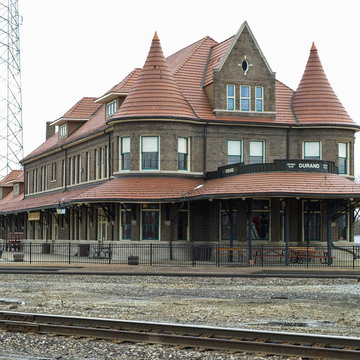You are here
Durand Union Station and Michigan Railroad History Museum (Durand Station of the Grand Trunk Western Railroad)
Durand became a major railroad center for the region and the state. The first railroad passed through in 1856, but by the early twentieth century the city was the largest railroad center outside Detroit. The Grand Trunk Western Railway Company of Canada built this large Richardsonian Romanesque station to serve one of the state's busiest railroad centers at the turn of the twentieth century. Fire destroyed it the same year it opened, but it was rebuilt immediately. The two-and-a-half-story building measures 49 × 244 feet. Tan Missouri granitory brick covers the exterior walls above a flared base of Bedford stone. The depot is topped with a gigantic hipped roof. A canopy, which encircles the station above the first story, shelters three sides of the depot. On the northwest side two symmetrical rounded bays with conical roofs flank a central pedimented gabled dormer. During its heyday in the 1910s and 1920s, the depot became the daily stop for thirty-five passenger, nine local, and one hundred freight trains. The general offices of the Grand Trunk Western Railroad and the freight and ticket offices of the Ann Arbor Railroad occupied the upper floor, and large waiting and dining rooms were on the lower floor. Once surrounded with a park and flower beds, the depot was considered the finest in the state, outside of the big cities. A forty-two-stall roundhouse formerly stood nearby. Amtrak's Bluewater train between Port Huron and Chicago stops at the station daily.
Writing Credits
If SAH Archipedia has been useful to you, please consider supporting it.
SAH Archipedia tells the story of the United States through its buildings, landscapes, and cities. This freely available resource empowers the public with authoritative knowledge that deepens their understanding and appreciation of the built environment. But the Society of Architectural Historians, which created SAH Archipedia with University of Virginia Press, needs your support to maintain the high-caliber research, writing, photography, cartography, editing, design, and programming that make SAH Archipedia a trusted online resource available to all who value the history of place, heritage tourism, and learning.







